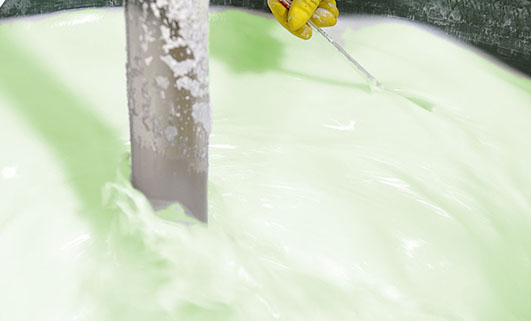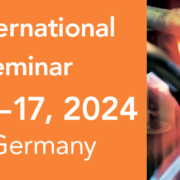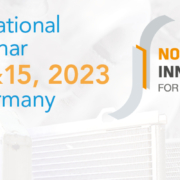Thermal management of electric vehicles is faced with challenges, as batteries need to be kept at a defined temperature range between 15°C and 35°C in order to function at peak performance throughout the life of a vehicle. The manufacture of such battery cooling systems involves controlled atmosphere brazing technology using noncorrosive flux. OEMs develop different battery cooler designs that require adapted fluxing methods.
Schlagwortarchiv für: CAB
Thermal management of electric vehicles is faced with challenges, as batteries need to be kept at a defined temperature range between 15°C and 35°C in order to function at peak performance throughout the life of a vehicle. The manufacture of such battery cooling systems involves controlled atmosphere brazing technology using noncorrosive flux. OEMs develop different battery cooler designs that require adapted fluxing methods.
The NOCOLOK International Brazing Seminar will provide information concerning the manufacturing practices commonly used for brazing operations and, in particular, will address the three fundamental aspects of the industrial-scale brazing of aluminium.
The NOCOLOK International Brazing Seminar will provide information concerning the manufacturing practices commonly used for brazing operations and, in particular, will address the three fundamental aspects of the industrial-scale brazing of aluminium.
During recent years, gel blockage in engine coolant systems with aluminum heat exchangers produced by CAB has gotten more and more attention in the automotive industry. A general understanding of gel formation processes in engine coolants and the role that flux residues on internal surfaces of brazed heat exchangers may or may not have is of significant interest.
The pandemic situation these days forces us to do things in a different way and to be more innovative. Therefore, the 20th annual technical training event was organized as a Google Meet Webinar – on 2 days tailored for NAM and Asia time zones beginning of November 2020.
On October 8th & 9th, 2019 – for the 18th time since 2001 – the Aluminium Brazing Seminar took place at Solvay Fluor in Hanover (Germany). There was a ‘full house’ with 31 participants from 12 countries – representing 15 companies – plus 5 Solvay participants joining this technical training.
What is NOCOLOK® Cs Flux (SM)? (Synthesized Material)
NOCOLOK® Cs Flux is used for brazing of aluminium alloys with higher magnesium levels. The Cs flux currently available for CAB (Controlled Atmosphere Brazing – furnace brazing) is a technical mixture (i.e. a mechanical blend) of K-Al-F flux (NOCOLOK® Flux) with Cs-Al-F flux – this product is offered under the name NOCOLOK® Cs Flux (TM): Technical Mixture.
The new NOCOLOK® Cs Flux (SM) is a fully synthesized material – i.e. a unique and homogenous product. The Cs is completely embedded in a Cs-K-Al-F matrix during the manufacturing process.
Advantages
When comparing the characteristics and application of blended Cs Flux „(TM)“ with synthesized material „(SM)“, there are notable advantages of the new quality:
- The mixture can show settling and separation in flux slurries and paints. This is caused by differences in the density, the particle size, and the solubility of the two compounds in the blend.
- In the new fully synthesized material – with the Cs completely incorporated in a Cs-K-Al-F matrix – the density is consistent and the particle size more uniform. We have a homogeneous powder with improved stability in suspensions (i.e. for slurries, paints, and pastes).
- In addition, the overall solubility is reduced when compared with the blended material.
- There will be less settling and less separation – which means that there is enhanced application performance with NOCOLOK® Cs Flux (SM).
NOCOLOK® Cs Flux (SM) is on stock at our Wimpfen facility and available right away.
Worldwide Registration
For a number of years, more and more countries are converting their existing chemical regulations or are implementing new regulations. In many cases, these regulations can be considered as an adaption of the European REACH Regulation. A registration of chemical substances or reaction masses is required, including comprehensive material data sets and risk assessment.
Solvay appreciates and supports these new product safety initiatives.
As a consequence, however, this leads to that in order to fulfill all regulatory requirements new products can only be introduced stepwise to other countries.
NOCOLOK® Cs Flux (SM) has already been successfully registered according to the European REACH Regulation and can be used without restriction within the European Union. Please also refer to our Safety Data Sheet, which is available on request. Registration for other countries/regions will be done successive. For more information, please contact our local sales offices.
Flux-Green-Filler-Stop (GFS) “stops” molten brazing filler metal from flowing into areas where it is unwanted, thus the surfaces remain clean and free from the presence of any filler metal.
Brazing filler metals do not like to bond with, or flow over, any dirt, grease, or oxides so the presence of any of such contaminants can prevent the filler metal from flowing over the surfaces of those parts to be brazed where these contaminants are located.

Therefore, GFS compounds are very effective at preventing molten filler metal flowing into protected areas. The GFS compounds are mixed with a liquid carrier solution and can be applied onto metal surfaces by using a small brush or by spraying or dipping.
For more information, please download the new brochure.


